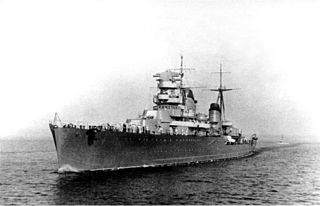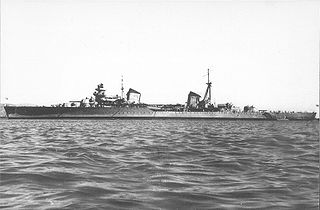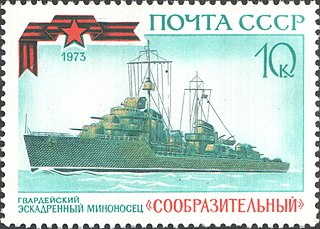Design
Following the October Revolution and the subsequent Russian Civil War, Soviet industry was not capable of designing large, complex warships by itself and sought foreign assistance. The Ansaldo company provided plans for the contemporary Raimondo Montecuccoli-class cruisers and a design displacing 7,200 tonnes (7,086 long tons ) and armed with six 180-millimetre (7.1 in) guns in twin turrets was produced in 1933. The Italians guaranteed that the cruiser could make 37 knots (69 km/h; 43 mph) on trials if the size was kept under the 7200-tonne limit. The designer of the new turret managed to persuade his superiors that he could fit triple turrets to the ship while keeping it within the specified limit, and this design was approved in November 1934 as the Project 26. [1]
The Soviets bought an example of, and plans for, the machinery of the later Duca d'Aosta-class cruisers and had some difficulty in adapting the smaller hull for the larger and more-powerful machinery, so much so that it delayed the start of construction. Another problem was that the Italian design had to be adapted to use the Soviet preference for a mix of longitudinal framing for the hull framing amidships and transverse framing for the ends, while also reinforcing the hull structure to withstand the more-severe weather conditions that the Soviets commonly encountered. [2]
The Kirovs were built in pairs, each pair incorporating some improvements over the earlier pair. These pairs were designated as the Project 26, Project 26bis, and Project 26bis2 in sequence. The differences between pairs usually related to size, armor, armament and aircraft. [3]
General characteristics
The Project 26 class ships were 191.3 m (627 ft 7 in) long overall. They had a beam of 17.66 m (57 ft 11 in) and at full load a draft of 6.15 m (20 ft 2 in). They displaced 7,890 tonnes (7,765 long tons) at standard load, and 9,436 tonnes (9,287 long tons) at full load. [4] Their single rudder meant that they were not very maneuverable. [5] Kirov and Voroshilov were fitted with a massive tetrapod foremast, but this proved to restrict the view from the conning tower as well as the fields of fire of the 100 mm anti-aircraft guns and greatly increased their silhouette. It was reduced to a simple pole mast in the later ships and the superstructure enlarged to accommodate the fire control facilities formerly housed in the foremast. [6]
Shortly after Kirov was launched in 1936, the two Project 26bis ships were laid down. They incorporated a number of changes from the first batch, not least of which was that they were larger. They displaced 8,177 tonnes (8,048 long tons) at standard load and 9,728 tonnes (9,574 long tons; 10,723 short tons) at full load. They were only slightly longer at 191.4 m (627 ft 11 in) overall and had a deep draft of 6.30 m (20 ft 8 in) at full load. On trials they proved to be the fastest ships of the class with a speed of 36.72 knots (68.01 km/h; 42.26 mph). Their armament was much the same as the earlier ships, although nine 45 mm (1.8 in) 61-K anti-aircraft guns were mounted rather than the six on the first pair and they were fitted to carry 150 Model 1908/39 mines in place of the Model 1912 mines. [4]
The Project 26bis2 pair were still larger and displaced 8,400 tonnes (8,267 long tons) at standard load, and 10,400 tonnes (10,236 long tons) at full load. They were a tenth of a meter shorter than the Project 26 ships, although the waterline length did not change at all between any of the pairs. Their turbines proved to be slightly more powerful than those of the Project 26bis ships and propelled them at 36 knots (67 km/h; 41 mph) on trials. Production delays with the 100 mm B-34 dual-purpose guns forced them to use 85 mm (3.3 in) 90-K guns instead and ten 37 mm (1.5 in) 70-K anti-aircraft guns supplemented the 45 mm guns. The mines changed yet again as they could carry 100 KB or 106 Model 1926 mines. [4]
Armament
The main armament consisted of three electrically powered MK-3-180 triple turrets with three 57-calibre 180 mm B-1-P guns. The turrets were very small to fit them into the hull space available and were so cramped that their rate of fire was much lower than designed (only two rounds per minute instead of six). The guns were mounted in a single cradle to minimize space and were so close together that their dispersion was very high because the muzzle blast from adjacent guns affected each gun. The turrets weighed approximately 236 to 247 tonnes (232 to 243 long tons), and the guns could be depressed to −4° and elevated to 48°. The guns fired 97.55-kilogram (215.1 lb) projectiles at a muzzle velocity of 900–920 m/s (3,000–3,000 ft/s); this provided a maximum range of around 38,000 m (42,000 yd), depending on ammunition and gun type. [7] Normally, 100 rounds per gun were carried, although an additional four rounds per gun could be carried at overload by the Project 26 ships only. [4]
The secondary armament consisted of six single 56-caliber 100-millimetre (3.9 in)B-34 anti-aircraft guns with 325 rounds per gun fitted on each side of the rear funnel in all ships except the Project 26bis2 which used eight single 52-caliber 85-millimetre (3.3 in)90-K guns with 300 rounds per gun when the B-34 program ran into problems. Light AA guns initially consisted of six semi-automatic 45 mm 21-K AA guns with 600 rounds per gun and four DK 12.7-millimetre (0.50 in) machine guns, with 12,500 rounds per gun, but were significantly increased in service. The Project 26bis ships carried nine 21-K mounts and the Project 26bis were built with an additional ten fully automatic 37-millimetre (1.5 in)70-K AA guns with a thousand rounds per gun. Over the course of World War II most, if not all, of the 45 mm guns were replaced by 37 mm guns and one or two Lend-Lease quadruple Vickers .50 machine gun MK III mounts were fitted to the ships in the Baltic and Black Seas, although each ship varied in its anti-aircraft suite. [8]
Six 533-millimetre (21.0 in)39-Yu torpedo tubes were fitted in two triple mountings; these tubes could be individually adjusted to spread out their salvos. Molotov and Kaganovich replaced their launchers with the more-modern 1-N mount during the war. A total of 96 KB or 164 Model 1912 mines could be carried by the first pair of ships. A pair of depth charge racks were mounted as well as four BMB-1 depth charge throwers. Twenty large BB-1 and thirty small BM-1 depth charges were carried although no sonar was fitted for the Project 26 and Project 26bis ships. They did mount the Arktur underwater acoustic communication system. Kalinin and Kaganovich received the Lend-Lease ASDIC-132 system, which the Soviets called Drakon-132, as well as the experimental Soviet Mars-72 sonar system. [9]
The Project 26 ships were fitted with the Molniya fire control system for their main guns which included the TsAS-2 mechanical computer and the KDP3-6 director. Each turret and the director had DM-6 rangefinders which allowed multiple targets to be engaged using a combination of local and central fire control. The four later ships had an improved Molniya-ATs fire control system which could accept data from spotter aircraft. The anti-aircraft armament was controlled by the Gorizont-1 system with a SO-26 computer, Gazon vertical gyroscope and a pair of SPN-100 directors on each side of the superstructure. Each director had a fully stabilized 3 m (9 ft 10 in) rangefinder. Voroshilov had SPN-200 directors, but the Project 26bis ships used the Gorizont-2 system. This had a more advanced Gorizont-2 computer and Shar vertical gyroscope. [10]
The first Soviet ship to carry a radar was Molotov which was given a Redut-K air warning system in 1940, which she used for the entire war. Lend-Lease radars equipped most of the other ships. The British Types 281, 291 and the American SG radars were used for air search. Main battery fire control radars were the British Types 284 and 285 while anti-aircraft fire control was provided by the Type 282 radar. Soviet-designed Yupiter-1 and Mars-1 gunnery radars were fitted in Molotov and Kalinin by 1944. [9]
Machinery
The ships had a twin-shaft-unit machinery layout with alternating boiler rooms and engine rooms. The machinery for Kirov was shipped from Italy (being diverted from the contract for the Italian cruiser Eugenio di Savoia). The machinery for the rest was built in Kharkiv to Italian plans. The Soviet TB-7 geared turbines proved to be more powerful and more economical than the originals. Kirov burned .8 kg (1.8 lb) of fuel oil per unit of horsepower compared to Kalinin's .623 kg (1.37 lb). Furthermore Kirov produced only 113,500 shaft horsepower (84,600 kW ) on trials while Voroshilov made 122,500 shp (91,300 kW) and was almost a full knot faster. Six license-built Yarrow-Normand type water-tube boilers powered the turbines with a nominal capacity of 106-tonnes/hour of superheated steam at a pressure of 25 kg/cm2 (2,452 kPa ; 356 psi ) and a temperature of 325 °C (617 °F). Each shaft drove a three-bladed 4.7-metre (15 ft) bronze propeller for a designed speed of 36 knots (67 km/h; 41 mph), although this varied from ship to ship. The normal oil capacity was between 600 and 650 tonnes (591 and 640 long tons), but the ships varied widely in the amount of oil carried at full load; this ranged from 1,150 to 1,660 tonnes (1,132 to 1,634 long tons). Endurance figures also varied widely at full load, from 2,140 to 4,220 nautical miles (3,960 to 7,820 km; 2,460 to 4,860 mi) at 18 knots (33 km/h; 21 mph). The maximum amount of fuel that could be carried ranged from 1,430 to 1,750 tonnes (1,407 to 1,722 long tons). [5]
Protection
The armour scheme formed a raft around the vitals, protected by a waterline belt, deck and traverse bulkheads uniformly 50 mm (2.0 in) in thickness. The turret and barbette armour was also 50 mm thick. The conning tower sides were 150 mm (5.9 in) with a 100 mm roof. A 20-millimetre (0.79 in) box protected the steering gear and a number of control positions were protected against splinters: 14 mm (0.55 in) for the torpedo control station, 8-millimetre (0.31 in) for main-battery fire control and secondary gun shields, 7 mm (0.28 in) for the secondary-battery control position and the auxiliary command station had 25-millimetre (0.98 in) sides and roof. [11]
The belt extended 121 m (397 ft 0 in) or 64.5% of the ship's length. Its total height was 3.4 m (11 ft 2 in), of which 1.33 m (4 ft 4 in) was below the designed waterline. A double bottom extended past the armored traverse bulkheads and a thin longitudinal bulkhead provided some measure of protection against flooding. It has been judged too thin to withstand a torpedo's detonation, but possibly the far-side bulkhead might survive intact, which would cause a list from asymmetrical flooding. [11]
The armor of the Project 26 ships was vulnerable even to destroyer-class weapons at ranges under 10 km (6.2 mi) and the last four ships were given additional armor. The belt, traverse bulkheads, barbettes and turret face thicknesses were all increased to 70 mm (2.8 in) and the box protecting the steering gear was increased to 30 mm (1.2 in). One oddity of the later ships' armor scheme was the joint between the armour deck and belt. The top and bottom edges of the belt were tapered, the outer surface angling in 200 mm (7.9 in) from the edge to a thickness of 45 mm. Similarly the deck edge was also tapered down to about 25 mm for its outermost 200 mm. It has been speculated that "This seam in the protection, representing a small target area, may simply have served to save weight and simplify construction." [12]
Aircraft
The Kirovs were designed to carry two aircraft, but German catapults had to be imported. Two Heinkel K-12 catapults were bought in 1937 for Kirov and Voroshilov. They could traverse 360° and launch an aircraft weighing 2,750 kg (6,060 lb) at a speed of 125 km/h (78 mph), although no suitable aircraft were in service until the KOR-1 seaplane entered service in September 1939. They proved to be unsuitable for rough-weather landings and were disembarked when Operation Barbarossa began. Gorky and Molotov mounted Soviet-built ZK-1 catapults of roughly comparable performance, but were destined never to use them for lack of suitable aircraft. [12]
The Project 26 ships landed their catapult during 1941 to make room for more AA guns, as did Molotov in 1942. A ZK-1a catapult was installed aboard Molotov in 1943, and she conducted successful experiments with a catapult-launched Supermarine Spitfire fighter. [11] The Project 26bis2 ships did not receive a catapult until after the end of the war, when a ZK-2b was fitted. The catapults, however, were removed from all ships by 1947. [11]












